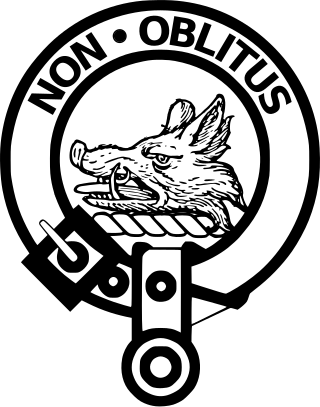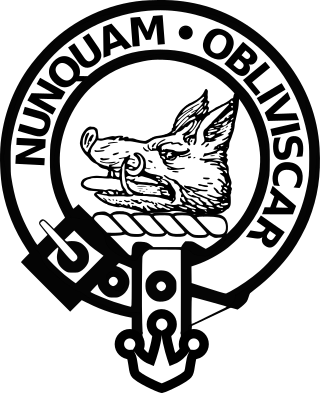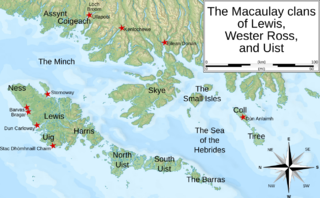Related Research Articles
A sept is a division of a family, especially of a Scottish or Irish family. The term is used in both Scotland and Ireland, where it may be translated as sliocht, meaning "progeny" or "seed", which may indicate the descendants of a person. The word may derive from the Latin saeptum, meaning "enclosure" or "fold", or via an alteration of "sect".

Clan Nicolson is a Lowland Scottish clan. The clan claims descent from an Edinburgh lawyer who lived in the 16th century and from a distinguished line of Aberdeen merchants who preceded him. During the mid-1980s David Nicolson, 4th Baron Carnock was recognised by the Lord Lyon King of Arms as the chief of Clan Nicolson. Around the same time, a Nicolson who claimed descent from the Highland clan of "Nicolsons" historically centred on Skye, petitioned the Lord Lyon King of Arms to be recognised as chief of his own clan. The Lord Lyon King of Arms accepted this man's petition on the condition he took the surname MacNeacail. In consequence there are two Scottish clans with similar names—the lowland Clan Nicolson and the highland Clan MacNeacail.

Clan MacNeacail, sometimes known as Clan MacNicol, is a Scottish clan long associated with the Isle of Skye. Tradition states that, early in its history, the clan held the Isle of Lewis, as well as extensive territory on the north-western mainland. The earliest member of the clan on record is one 14th century John "mak Nakyl", who is recorded amongst Edward I of England's powerful West Highland supporters during the Wars of Scottish Independence. John Barbour's 1375 epic, The Brus, suggests that by 1316, the clan had switched allegiance to Robert I, and made a decisive intervention in the new theatre of Anglo-Scottish conflict in Ireland. The marriage of an heiress to the MacLeods of Lewis brought a severe loss of lands and power in the following generation, forcing the clan chiefs to relocate to the surviving estates on Skye. However, the MacNeacails retained local significant influence: serving, according to tradition, as members of the Council of the Lords of the Isles and as custodians of the cathedral church of the Western Isles at Snizort. In the 17th century, members of the clan began to Anglicise their surname from the Scottish Gaelic MacNeacail to various forms, such as Nicolson. Today the English variants of the Gaelic surname are borne by members of the clan as well as members of unrelated Scottish families, including the Lowland Clan Nicolson.

Clan MacDougall is a Highland Scottish clan, historically based in and around Argyll. The Lord Lyon King of Arms, the Scottish official with responsibility for regulating heraldry in Scotland, issuing new grants of coats of arms, and serving as the judge of the Court of the Lord Lyon, recognizes under Scottish law the Chief of Clan MacDougall. The MacDougall chiefs share a common ancestry with the chiefs of Clan Donald in descent from Somerled of the 12th century. In the 13th century the Clan MacDougall whose chiefs were the original Lords of Argyll and later Lords of Lorne was the most powerful clan in the Western Highlands. During the Wars of Scottish Independence the MacDougalls sided with the Clan Comyn whose chiefs rivaled Robert the Bruce for the Scottish Crown and this resulted in clan battles between the MacDougalls and Bruce. This marked the MacDougall's fall from power and led to the rise of their relatives, the Clan Donald, who had supported Bruce and also the rise to power of the Clan Campbell who were then the habitual enemies of the MacDougalls and later of Clan Donald.
A formal Gaelic language name consists of a given name and a surname. First names are either native or nativized. Surnames are generally patronymic, i.e. they refer to a historical ancestor. The form of a surname varies according to whether its bearer is male or female though for some surnames the adjectival form of a name such as Dòmhnallach can be used for both men and women. However, when used in the female form the first letter is lenited.

Clan Darroch is a Scottish clan. The current Chief of the Name and Arms of Darroch as recognized by the Lord Lyon King of Arms is descended from the Darrochs of Jura.

Clan MacTavish is an Ancient Highland Scottish clan.

Clan Macfie is a Highlands Scottish Clan.

Clan MacAulay, also spelt Macaulay or Macauley is a Scottish clan. The clan was historically centred on the lands of Ardincaple, which are today consumed by the little village of Rhu and burgh of Helensburgh in Argyll and Bute. The MacAulays of Ardincaple were located mainly in the traditional county of Dunbartonshire, which straddles the "Highland Line" between the Scottish Highlands and Lowlands. Clan MacAulay has been considered a "Highland clan" by writers and has been linked by various historians to the original Earls of Lennox and in later times to Clan Gregor. The MacAulays of Ardincaple, like Clan Gregor and several other clans, have traditionally been considered one of the seven clans which make up Siol Alpin. This group of clans were said to have claimed descent from Cináed mac Ailpín, King of the Picts, from whom later kings of Scotland traced their descent. The chiefs of Clan MacAulay were styled Laird of Ardincaple.

Clan MacIver or Clan MacIvor, also known as Clan Iver, is a Scottish clan recognised by the Lord Lyon King of Arms. The clan, however, does not have a chief recognised by the Lord Lyon King of Arms. Because of this the clan can be considered an armigerous clan. The clan name of MacIver is of Gaelic origin, derived from an Old Norse personal name. Various forms of the surname MacIver, like MacGiver, are considered sept names of several historically large Scottish clans, such as clans Campbell and Mackenzie. There exists a Clan Iver society in Fife, Scotland.

Clan MacEwen or Clan MacEwan is a Scottish clan recorded in the fifteenth century as Clan Ewen of Otter.

The Macaulay family of Uig in Lewis, known in Scottish Gaelic as Clann mhic Amhlaigh, were a small family located around Uig on the Isle of Lewis in the Outer Hebrides of Scotland. There is no connection between the Macaulays of Lewis and Clan MacAulay which was centred in the Loch Lomond area, bordering the Scottish Highlands and Scottish Lowlands. The Macaulays of Lewis are generally said to be of Norse origin because of the etymology of their surname and also because of the islands' Viking Age past. However, a recent analysis of the Y-DNA of men with Scottish surnames has shown that a large number of Hebridean Macaulays are of Irish origin. In the 17th century, however, tradition gave the Macaulays an Irish origin. By the end of the 16th century the dominant clan on Lewis was Clan Macleod of The Lewes. Other notable Lewis clans were the somewhat smaller Morrisons of Ness and the even less numerous Macaulays of Uig. The Macaulays were centred in the area surrounding Uig on the western coast of Lewis, and had a deadly, long-standing feud with the Morrisons, whose lands were located on the northern coast around Ness. Today the Lewis surname Macaulay is considered to be a sept name of the Macleods of Lewis. There are two other nearby clans of Macaulays who may, or may not, be connected to the Lewis clan—the Wester Ross Macaulays, and the Uist MacAulays.

A Scottish crest badge is a heraldic badge worn to show allegiance to an individual or membership in a specific Scottish clan. Crest badges are commonly called "clan crests", but this is a misnomer; there is no such thing as a collective clan crest, just as there is no such thing as a clan coat of arms.

A clan badge, sometimes called a plant badge, is a badge or emblem, usually a sprig of a specific plant, that is used to identify a member of a particular Scottish clan. They are usually worn affixed to the bonnet behind the Scottish crest badge, or pinned at the shoulder of a lady's tartan sash. According to popular lore clan badges were used by Scottish clans as a means of identification in battle. An authentic example of plants being used in this way were the sprigs of oats used by troops under the command of Montrose during the sack of Aberdeen. Similar items are known to have been used by military forces in Scotland, like paper, or the "White Cockade" of the Jacobites.

Clan McCorquodale is a Scottish clan, recognised by the Lord Lyon King of Arms, though without a chief so recognised. The last chief of the clan died in the 18th century. Because the clan does not have a recognised chief, it is considered an armigerous clan, and has no legal standing under Scots Law. Historically, the clan inhabited lands west of Loch Awe, in Argyll. These clan lands were centred at Loch Tromlee, where an island castle served as the clan seat. The line of Clan McCorquodale chiefs, first recorded in the 15th century, has been untraced since the 18th century.
MacLeòid or MhicLeòid is a masculine surname in Scottish Gaelic. The name translates into English as "son of Leòd", and the feminine form is NicLeòid: a contraction of "Nighean-Mhic-Leòid", meaning "daughter of the son of Leòd." These surnames originated as patronymic names; however, they no longer refer to the actual name of the bearer's father or grandfather. There are numerous Anglicised forms of MacLeòid.
Paul Mactire, also known as Paul MacTyre, and Paul M'Tyre, was a 14th-century Scotsman who lived in the north of Scotland. He appears in several contemporary records, as well as in a 15th-century genealogy which records his supposed ancestry. He is known to have married a niece of the brother of the Earl of Ross. According to later tradition, he was a notorious robber, or freebooter in the north of Scotland; and, according to local tradition, he was the builder of a now ruinous fortress in Sutherland. He is said to be the ancestor of several Scottish families. According to some sources Paul Mactire's father was Leod Macgilleandrais.

Suibhne mac Duinnshléibhe was a late 12th-century, and early 13th-century, lord in Argyll. He does not appear in contemporary records, although his name appears in the patronymic names of two of his sons. Suibhne appears in the 16th century Leabhar Chlainne Suibhne, which documents the early history of Clann Suibhne. This account claims that he is the ancestor of Irish clan, and that he was the builder of Castle Sween in Knapdale, Argyll. However, other sources suggest the castle was built in the late 11th century by Suibhne MacAnrahan, brother of the High King of Ireland. Suibhne is said to be identical to the "Swineruo", or Suibhne Ruadh, recorded in the Ane Accompt of the Genealogie of the Campbells, a 17th-century Clan Campbell genealogy.
MacMhuirich is a masculine surname in Scottish Gaelic. The feminine form of the surname is NicMhuirich. The masculine form translates into English as "son of Muireach", and the feminine name translates as "daughter of MacMhuirich". The personal name Muireach means "mariner". The surname has been borne by a noted Hebridean family of bards, who claimed descent from an early 13th-century Irish bard.

Clan MacPhail or the Sons of Paul is a Scottish clan of the Scottish Highlands. Known in Scottish Gaelic as Conchie Dhu or Condochy Doye, the clan is mainly associated with the confederation of Clan Chattan.
References
- Footnotes
- ↑ Black 1946: pp. xix-xx.
- 1 2 Reaney 2006: Introduction: Scottish surnames
- 1 2 3 4 Black 1946: pp. xxiv-xxv.
- ↑ Thomason 1834: p. 124.
- ↑ Thomason 1834: pp. xxiv-xxv.
- 1 2 3 Scottish Surnames and Variants, ScotlandsPeople (www.scotlandspeople.gov.uk), retrieved 5 August 2010
- 1 2 Black 1946: p. xlii.
- 1 2 3 4 Black 1946: pp. xxv-xxvii.
- 1 2 3 4 5 6 Surnames Derived from Place Names, AskOxford.com, archived from the original on 17 January 2013
- ↑ Blakely 2005: p. 5.
- ↑ "Learn about the family history of your surname". Ancestry.com . Retrieved 2 September 2010. which cited Dictionary of American Family Names. Oxford University Press. ISBN 0-19-508137-4. for the surname "Graham".
- 1 2 3 4 Nicolaisen 1986: p. 96.
- 1 2 3 Bowie, Neil; Jackson, G. W. L. (2003). "Surnames in Scotland over the last 140 years". www.nrscotland.gov.uk. National Records of Scotland . Retrieved 14 October 2016.
- ↑ Black 1946: pp. xxviii-xxix.
- 1 2 3 4 Mac an Tàilleir, Iain. "Ainmean Pearsanta" (docx). Sabhal Mòr Ostaig . Retrieved 15 October 2009.
- ↑ "Learn about the family history of your surname". Ancestry.com . Retrieved 7 September 2010. which cited Dictionary of American Family Names. Oxford University Press. ISBN 0-19-508137-4. for the surname "McPherson".
- 1 2 3 Black 1946: pp. xxx-xxxii.
- 1 2 3 4 Black 1946: pp. xxxvii-xxxviii.
- ↑ Clan Donald USAGenetic Genealogy Project, Clan Donald USA Genealogy Project (dna-project.clan-donald-usa.org), retrieved 31 August 2010
- ↑ Mackenzie 1903: p. 64.
- ↑ Campbell of Airds 2000: pp. 238-240.
- ↑ Black 1946: pp. 505–506.
- ↑ Black 1946: pp. 104-105.
- ↑ Mac Giolla-Domhnaigh 1923: p. 4.
- ↑ MacLysaght 1996: p. 246.
- 1 2 Campbell of Airds 2000: p. 7.
- ↑ Fraser, C.I of Reelig (1954). The Clan Munro. Stirling: Johnston & Bacon. p. 15. ISBN 0-7179-4535-9.
- 1 2 Burnett 1997: p. 41.
- ↑ Who is a member of a clan?, Court of the Lord Lyon (www.lyon-court.com), retrieved 31 August 2010
- ↑ Campbell of Airds 2004: p. 186.
- ↑ Campbell of Airds 2000: p. 235.
- ↑ Bannerman 1996: p. 20.
- ↑ Black 1946: pp. xxxviii-xl.
- ↑ Graham-Campbell; Batey 1998: pp. 71–72.
- ↑ Black 1946: pp. xliv-xlv.
- ↑ Clann ’ic Shimidh (Litir Bheag 67) by Ruairidh MacIlleathain.
- ↑ McElduff, Fiona; Mateos, Pablo; Wade, Angie; Borja, Mario Cortina (2008), "What's in a name? The frequency and geographic distributions of UK surnames" (pdf), Significance , The Royal Statistical Society, 5 (4): 189–192
- ↑ Henderson 1910: p. 57.
- ↑ "Recording Changes of Forename(s) and Surname(s) in Scotland", www.nrscotland.gov.uk, National Records of Scotland, retrieved 14 October 2016
- ↑ "Leaflet RCN1: Recording changes of forename(s) and surname(s) in Scotland" (pdf), www.nrscotland.gov.uk, National Records of Scotland, retrieved 14 October 2016
- ↑ "Mackenzie". AskOxford.com. Archived from the original on 7 June 2011. Retrieved 17 April 2010. which cited Concise Dictionary of First Names . Oxford University Press.
- ↑ "Cameron". AskOxford.com . Retrieved 8 September 2010.[ dead link ] which cited Concise Dictionary of First Names . Oxford University Press.
- Bibliography
- Bannerman, John (1998), "MacDuff of Fife", in Grant, Alexander; Stringer, K.J. (eds.), Medieval Scotland: Crown, Lordship and Community: Essays presented to G.W.S. Barrow, Edinburgh: Edinburgh University Press, ISBN 978-0-585-06064-4
- Black, George Fraser (1946), The Surnames of Scotland: Their Origin, Meaning, and History, New York: New York Public Library
- Blakely, Ruth M. (2005), The Brus Family in England and Scotland 1100-1295, Woodbridge, Suffolk: The Boydell Press, ISBN 1-84383-152-X
- Burnett, Charles J.; Dennis, Mark D. (1997), Scotland's Heraldic Heritage; The Lion Rejoicing, Edinburgh: The Stationery Office
- Campbell of Airds, Alastair (2000), A History of Clan Campbell; Volume 1; From Origins to Flodden, Edinburgh: Polygon, ISBN 1-902930-17-7
- Campbell of Airds, Alastair (2002), A History of Clan Campbell; Volume 2; From Flodden to the Restoration, Edinburgh: Edinburgh University Press, ISBN 1-902930-18-5
- Campbell of Airds, Alastair (2004), "The Early Families of Argyll", in Omand, Donald (ed.), The Argyll Book, Edinburgh: Birlinn, ISBN 1-84158-253-0
- Graham-Campbell, James; Batey, Colleen E. (1998), Vikings in Scotland: An Archaeological Survey, Edinburgh University Press, ISBN 978-0-585-12257-1
- Harrison, Henry (1918), Surnames of the United Kingdom: A Concise Etymological Dictionary, vol. 2, London: The Mortland Press
- Henderson, George (1910), The Norse Influence on Celtic Scotland, Glasgow: James Maclehose and Sons
- Mac Giolla-Domhnaigh, Padraig (1923), Some Anglicised Surnames in Ireland, Dublin: The Gael Co Operative Society
- Mackenzie, William Cook (1903), History of the Outer Hebrides, Paisley: Alexander Gardner
- MacLysaght, Edward (1996), More Irish families (New, revised, and enlarged ed.), Portland: Irish Academic Press
- Nicolaisen, W. F. H. (1986), "Tension and Extension: Thoughts on Scottish Surnames and Medieval Popular Culture", in Campbell, Josie P. (ed.), Popular culture in the Middle Ages , Popular Press, ISBN 978-0-87972-339-2
- Reaney, Percy Hilde; Wilson, Richard Middlewood (2006), A Dictionary of English Surnames (3rd ed.), London: Routledge, ISBN 0-203-99355-1
- Thomson, Thomas, ed. (1834), Instrumenta Publica Sive Processus Super Fidelitatibus Et Homagiis Scotorum Domino Regi Angliae Factis, A.D. MCCXCI-MCCXCVI., Edinburgh: Bannatyne Club